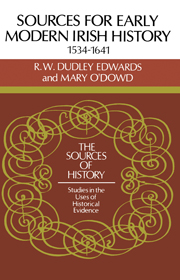Book contents
- Frontmatter
- Contents
- Acknowledgements
- Abbreviations
- Introduction
- 1 IRISH CIVIL CENTRAL ADMINISTRATION
- 2 IRISH CIVIL LOCAL ADMINISTRATION
- 3 ENGLISH AND OTHER CENTRAL ADMINISTRATIONS AND IRELAND
- 4 IRISH ECCLESIASTICAL ADMINISTRATION
- 5 CONTEMPORARY ACCOUNTS AND DESCRIPTIONS
- 6 MAPS AND DRAWINGS
- 7 ARCHIVAL COLLECTIONS
- 8 HISTORIOGRAPHY
- Index
5 - CONTEMPORARY ACCOUNTS AND DESCRIPTIONS
Published online by Cambridge University Press: 08 January 2010
- Frontmatter
- Contents
- Acknowledgements
- Abbreviations
- Introduction
- 1 IRISH CIVIL CENTRAL ADMINISTRATION
- 2 IRISH CIVIL LOCAL ADMINISTRATION
- 3 ENGLISH AND OTHER CENTRAL ADMINISTRATIONS AND IRELAND
- 4 IRISH ECCLESIASTICAL ADMINISTRATION
- 5 CONTEMPORARY ACCOUNTS AND DESCRIPTIONS
- 6 MAPS AND DRAWINGS
- 7 ARCHIVAL COLLECTIONS
- 8 HISTORIOGRAPHY
- Index
Summary
CONTINENTAL ACCOUNTS OF IRELAND
The medieval visitor to Ireland frequently seems to remind us of a Victorian traveller in darkest Africa. Through the ages travellers have often emphasised the primitive and unusual in stories and descriptions aimed at a greedy and sensation-minded public. Much of rural western Europe provided or could have provided material for such travellers, even more recently than in pre-Cromwellian Ireland. Until England's breach with Rome much of the geography of Ireland remained unknown except through occasional travellers. Many of these came on pilgrimage from the continent to Saint Patrick's Purgatory or would regard that as an essential place to visit if in Ireland on other business. The accounts of such travellers which have come down to us are of much the same pattern, centred around encounters with local chiefs, usually hospitable and sometimes concerned to secure from their visitors substantial rewards for their attentions.
The bleakness of life outside the castles of the great and the risks and dangers to which visitors were exposed were as clear as they had been in Primate Colton's visitation of Derry in the late fourteenth century, as they had been to Chiericati in 1520, and to Bishop Monluc who visited O'Doherty on Inishowen, just as they were to the first Jesuits Salmeron and Brouet who quickly withdrew from Ireland when they realised that Tyrone feared to entertain them in defiance of Henry VIII's displeasure.
The surviving descriptions which have been located of Charles V's emissaries in Ireland and those of later European monarchs, while business-like regarding the resources of revolting lords like Desmond, O'Brien or O'Neill, are not dissimilar to such early Tudor reports, from viceroys penetrating remote and inaccessible areas, as those of Lord Leonard Grey in the late 1530s.
- Type
- Chapter
- Information
- Sources for Modern Irish History 1534–1641 , pp. 83 - 105Publisher: Cambridge University PressPrint publication year: 1985



